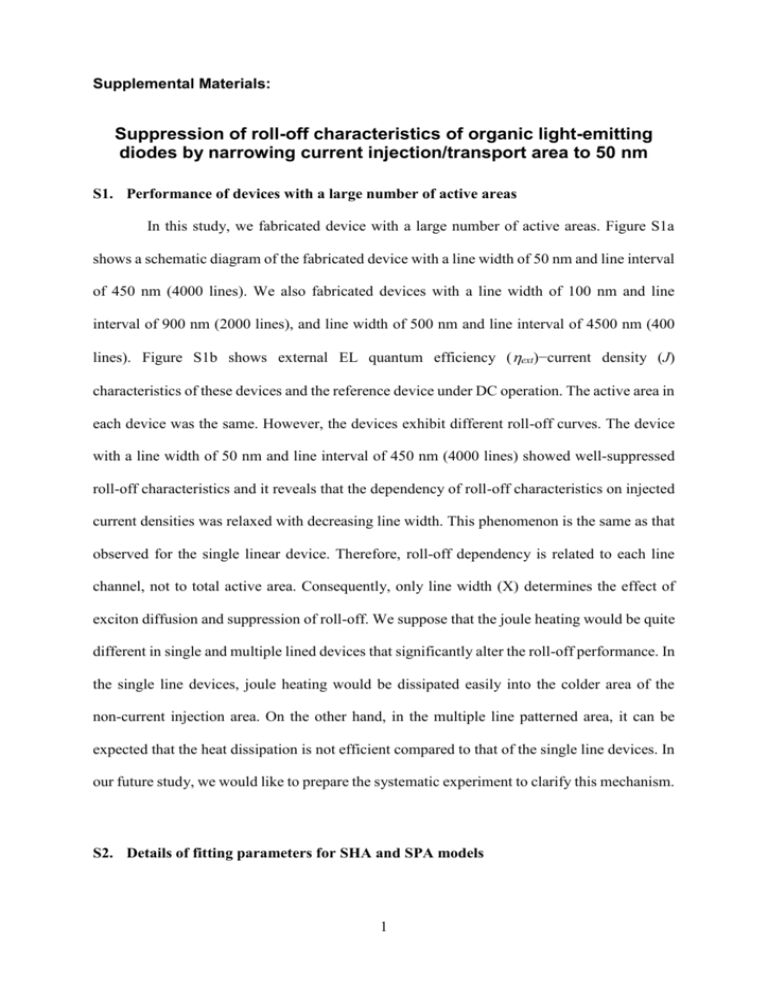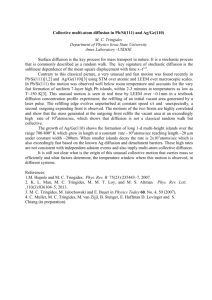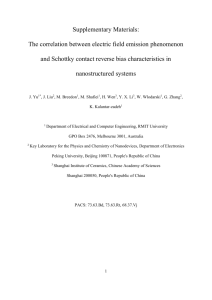Supplemental figure legends
advertisement

Supplemental Materials: Suppression of roll-off characteristics of organic light-emitting diodes by narrowing current injection/transport area to 50 nm S1. Performance of devices with a large number of active areas In this study, we fabricated device with a large number of active areas. Figure S1a shows a schematic diagram of the fabricated device with a line width of 50 nm and line interval of 450 nm (4000 lines). We also fabricated devices with a line width of 100 nm and line interval of 900 nm (2000 lines), and line width of 500 nm and line interval of 4500 nm (400 lines). Figure S1b shows external EL quantum efficiency (ext)−current density (J) characteristics of these devices and the reference device under DC operation. The active area in each device was the same. However, the devices exhibit different roll-off curves. The device with a line width of 50 nm and line interval of 450 nm (4000 lines) showed well-suppressed roll-off characteristics and it reveals that the dependency of roll-off characteristics on injected current densities was relaxed with decreasing line width. This phenomenon is the same as that observed for the single linear device. Therefore, roll-off dependency is related to each line channel, not to total active area. Consequently, only line width (X) determines the effect of exciton diffusion and suppression of roll-off. We suppose that the joule heating would be quite different in single and multiple lined devices that significantly alter the roll-off performance. In the single line devices, joule heating would be dissipated easily into the colder area of the non-current injection area. On the other hand, in the multiple line patterned area, it can be expected that the heat dissipation is not efficient compared to that of the single line devices. In our future study, we would like to prepare the systematic experiment to clarify this mechanism. S2. Details of fitting parameters for SHA and SPA models 1 The ext−J characteristics in the SHA and SPA models under steady-state conditions are given by the following equations1: 𝜂 𝜂0 = 1 𝐽 𝐽0 1+( ) (S-1) 1⁄ 𝑙+1 æ ö 1 (1+ ) 1 J0 ç h J 2 l = 1+ 8 - 2t ksq kth J -1÷ ÷ h0 4J çè J0 al ø (S-2) where is fluorescence lifetime, ksq is the singlet-singlet quenching parameter, is the constant for J∝Vm+1 in the TCLC model and kth is the singlet quenching parameter caused by Joule heating. The best fit was obtained with J0 = 1950 mA/cm2 and l = 1.5 for the SPA model and J0 = 390 mA/cm2, l = 0.35 and 2ksqkth = 1 10-10 for the SHA model in Figure 4(b). S3. Estimation of the exciton diffusion length of BSB-Cz We estimated the exciton diffusion length (LD) of a BSB-Cz molecule by using a PL quenching technique to solve an exciton diffusion equation.2 Here, a molybdenum (VI) oxide (MoO3) layer was used as an exciton quencher. The work function of the MoO3 layer (5.68 eV) is located well below the rather shallow lowest unoccupied molecular orbital (LUMO) level of a BSB-Cz layer (3.1 eV) and the PL spectrum of BSB-Cz and absorbance of MoO3 do not overlap. Figure S2a shows the PL spectrum of BSB-Cz and absorption spectrum of the MoO3 layer. Here, the excitons of BSB-Cz molecules generated by photoabsorption in the BSB-Cz layer were diffuse, and when excitons reached to the BSB-Cz / MoO3 interface, exciton quenching occurred because of an energy transfer process from BSB-Cz to MoO3. The exciton diffusion efficiency (ED) is defined as: 𝜂𝐸𝐷 = 1 − 2 𝑃𝐿1 𝑃𝐿2 (S-3) where PL1 and PL2 are the PL intensities of a BSB-Cz layer with and without a MoO3 interface. ED can also be obtained from LD and film thickness (d) as follows: 𝜂𝐸𝐷 = 𝐿𝐷 [1 − exp(−2𝑑 ⁄𝐿𝐷 )] 𝑑 [1 + exp(−2𝑑 ⁄𝐿𝐷 )] (S-4) Using both eq. S-3 and S-4, we can estimate the LD of a BSB-Cz layer. To estimate the exciton diffusion length, we prepared two kinds of films by vacuum deposition, as shown in Figure S2b. 1) quartz / BSB-Cz (d nm) film, 2) quartz / MoO3 (10 nm) / BSB-Cz (d nm) film. Then, we compared the PL intensities of the two films for different thicknesses of the BSB-Cz layer from 5 to 30 nm. Figure S2c shows the dependence of BSB-Cz layer thickness on PL1 / PL2, and solid lines show the theoretically calculated values for LD = 12, 13 and 14 nm. From Figure S2c, we estimated that LD is 13±1 nm. S4. Estimation of lateral charge diffusion According to the Einstein relationship, charges undergo diffusion with diffusion coefficient 𝐷 = 𝑘𝑇𝜇/𝑞, where µ is the charge carrier mobility. Then, the spatial extent of charge diffusion can be estimated by 𝐿𝑐ℎ = √𝜏𝐷, where τ is the time of flight of a charge 𝑑 through the layer of organic semiconductor. The time of flight can be estimated as 𝜏 = 𝜇𝐸 = 𝑑2 𝜇𝑉 , where d is the film thickness, and E is the electric field that is created in the device by the 𝑘𝑇 applied voltage V. Then, we find that Lch is independent of mobility: 𝐿𝑐ℎ = 𝑑√𝑉𝑞. Figure S3 shows Lch versus V for device thickness d = 100 nm at room temperature. References 3 1 H. Nakanotani, H. Sasabe, and C. Adachi, Appl. Phys. Lett. 86, 213506 (2005). 2 P. Peumans, A. Yakimov, and S. R. Forrest, J. Appl. Phys. 93, 3693 (2003). 4 Supplemental figure legends FIG. S1. Schematic diagram of fabricated device with line width of X and line interval of Y. (b) External EL quantum efficiency (ηext)−J characteristics of devices with X = 50 nm and Y = 450 nm (4000 lines), X = 100 nm and Y = 900 nm (2000 lines) and X = 500 nm and Y = 4500 nm (400 lines) and the reference device under DC operation. FIG. S2. (a) PL spectrum of BSB-Cz and the absorbance of MoO3. (b) Schematic diagram of the quartz / MoO3 (10 nm) / BSB-Cz (d nm) film. (c) BSB-Cz layer thickness dependence on PL1 / PL2 and calculated results based on eq. (S-3) and (S-4) (LD = 12, 13 and 14 nm). FIG. S3. Dependence of lateral charge diffusion length on applied voltage for a device thickness of 100 nm at room temperature. 5 Fig. S1 6 Fig. S2 7 Fig. S3 8











